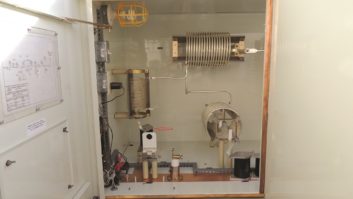Experts Say ‘No More Shortcuts’in Tower Design, Rating
Broadcasters with new antenna projects or those planning to make changes to existing antenna support structures will be confronted with myriad revisions made to the national standard governing construction of steel antenna towers in this country. Some of the revisions may cost broadcasters more money than they had budgeted for projects.
The Telecommunications Industry Association/Electronic Industries Alliance 222-G tower rating standard, “Structural Standards for Steel Antenna Towers and Antenna Supporting Structures,” which went into effect this month, incorporates new engineering practices meant to ensure the structural integrity of antenna support structures.
Possibly the biggest change for broadcasters, industry observers say, is that now, instead of a single tower design standard to follow, several classifications are now possible, allowing broadcasters some flexibility in structure design.
While 222-G is considered a voluntary standard, experts said it will gain teeth after being referenced by the International Building Code and adopted by local permitting jurisdictions.
Gauging the load
A shift in contemporary building codes to a performance-based approach in factoring extreme loading conditions – called “load resistance factor design,” also known as limit states design – precipitated the Revision G, according to Craig Snyder. He is chairman of the TIA committee for tower writing and president of Sioux Falls Tower and Communications.
“Around the world there has been a shift in how structural engineers look at things. The move is away from ‘allowable stress design’ and toward ‘limit states design.’ Those developments required a major revision to the tower standard,” Snyder said.
Allowable stress design applies a single “factor” of safety to the ultimate capacity of the tower member, based upon the type of capacity that is defined. The result is an allowable capacity, which is then compared to the load or loads induced, regardless of the type of load, according to John Erichsen, principal of EET Llc., a structural engineering consulting firm.
Meanwhile, limit states design applies a magnifying factor to each load based upon several considerations, including comfort level. Structural engineers have to predict the load. For example, the weight of the structure will get a lower factor when compared to a load induced by wind. The engineer considers the probability that any given load will occur in conjunction with another, Erichsen said.
“Limit states design also assigns a discounting factor to the ultimate capacity of each member based upon the reliability of the member and its role within the overall design,” Erichsen said.
Existing towers are grandfathered in, Snyder said, but such broadcast towers will need to be reanalyzed under 222-G if modifications are made. Depending on the findings, that could cost owners money.
“If you go from an eight-bay antenna to a 10-bay antenna or looking to host additional systems, then the tower will have to be reanalyzed to determine its support capacity and compliance,” Snyder said. “That could be an advantage or disadvantage. It could mean they’ll have to beef up their foundations.”
222-G affects existing and proposed AM antenna structures as well as towers supporting FMs, Snyder said.
Snyder and his committee of tower erection contractors and structural engineers began work on the latest revision – considered the largest to the rules since tower standards were adopted more than 50 years ago – in 1998. The American National Standards Institute requires that tower standards be reviewed every five years.
Among the new provisions in 222-G are load calculations for wind and ice loading, topographic categories, design stresses, soil parameters, climbing safety and seismic loading considerations for towers in areas prone to earthquakes.
Possibly the biggest change in the tower standard, and the one that could have the greatest impact on broadcasters, is the introduction of three structure classifications, he said.
Category I structures present a low hazard to human life and are used for non-critical communication services. Category II structures represent a substantial risk to human life and are used for services that could be provided by other means. Category III structures are considered essential facilities with substantial risk to human life upon failure, Snyder said.
Broadcast towers might be classified into any of the three, Snyder said, depending on location and whether they are considered essential facilities.
“Not all structures will be treated equally. Before, it was a one-size-fits-all standard. Now, some structures will require higher reliability standards,” Snyder said. “The advantage is that one could down-rate their structure if it’s in the middle of a cornfield and not essential, so it could be built with lighter weight materials. There is a risk and reward now for broadcasters willing to take a bit of risk.”
The owner/user and the structural engineer of record decide the tower’s classification, Snyder said, with the structural engineer having the final say.
Ice and soil
Revision G will result in a more thorough analysis of towers while eliminating shortcuts in the design of structures, Snyder said.
“Overall, there will be benefits to broadcasters in terms of acceptance of this new standard and in keeping with engineering principals across the board. It may be more restrictive in some cases, but less so in others. Our preliminary results show some loads getting lighter and others getting heavier. We just don’t have enough data yet,” Snyder said.
John Wahba, senior vice president of engineering for Radian Communications Services, said 222-G requires that wind loading be calculated using three-second wind gusts, instead of fastest mile per hour. It also eliminates the use of the “normal soil” definition, replacing it with “presumptive” soil parameters for use in clay and sandy soils, which will likely require geotechnical reports.
Defining the characteristics of the soil allows structural engineers to use more exact parameters when determining bearing load capacities and tower anchoring minimums, Wahba said.
“Ice is another major change. In some areas you’ll have to use more or less. There is much more specific data collected by the National Weather Service, which is broken down county by county, including wind and ice,” Wahba said. “The new standard is much more demanding in the number of calculations required and much more prescriptive in terms of how to handle loading.”
It’s hard to say if the tower revisions will equal increased design and construction costs for broadcast projects, Wahba said; the revisions may save money in some cases and not in others.
“In terms of analysis, it will take structural engineers longer to evaluate new projects or existing towers. They’ll also need to equip themselves with new tools and software. There will be a learning curve. However, depending on the classification, the material cost could be lower,” Wahba said.
Radio impact
222-G will require broadcast engineers to “familiarize themselves with the updates and be aware of any changes made to their towers,” said Mark Malouf, president of Malouf Engineering, a structural engineering consulting firm.
“They need to understand that the dynamics have changed and that they have potentially more flexibility with their towers. A lot of the gray areas have been addressed. There should be no more guessing on things,” Malouf said.
Broadcasters say they have been following the tower industry developments closely because the changes will affect current and future tower projects.
“We have had structural engineers and other experts in this area speak to our regional engineering vice presidents to discuss the changes,” said Steve Davis, senior vice president of engineering for Clear Channel Radio. “We expect it will add to our costs in some cases.”
Marty Hadfield, vice president of engineering for Entercom, said, “We look at towers as ‘vertical real estate,’ and the changes will likely impact the structural capacity for future expansion for existing towers. We will pass any structural improvement costs to the prospective tenants, if we make changes.”
The changes will “certainly have a significant impact in any future tower projects or tower renovations,” said Milford Smith, vice president of engineering for Greater Media.
“I would anticipate cost increases in some, if not most, situations compared to structures completed under the old standards.”
The latest revision should have “little impact on the daily routine” of broadcast engineers, said Chriss Scherer, president of the Society of Broadcast Engineers.
“The heart of the revision covers loading and construction issues, which are more of a concern to structural engineers. However, just like familiarity with FCC rules is important, it’s good for station engineers to know the standards for reference,” Scherer said.
Scherer said SBE is considering ways to help disseminate the information with several sources being considered as a part of member services.
Climber safety requirements, which have been largely ignored in previous tower standard revisions, were addressed this time around, Malouf said.
“Safety requirements for safety access are now in place. There are signage requirements now for the structure, including radiation field warnings and tripping hazards for climbers,” Malouf said.
Readers can purchase the Revision G tower standard at www.tiaonline.org
Notable Changes to 222-G:
Geotechnical Investigations: Used to determine the ultimate bearing capacities for each soil layer at recommended bearing depth.
Presumptive Soil Parameters: Specific parameters for sand and clay soils allow structural engineers to use more exact parameters when determining bearing load capacities and tower anchoring minimums.
Classification of Structures: Structures will now be classified as Class I, II or III. Order of classifications will be dependent upon location of structure, hazard to human life in the event of failure and essential communications necessity.
Climber Safety: New minimum requirements for the design and construction of fixed ladders, safety devices, climber attachment anchorages, platforms and cages will make for safer conditions for climbers.
Basic Wind Speed and Design Ice Thickness: Extensive data collected from the National Weather Service will be used in regional estimations for determining load limits.
Topographic Categories: Wind speed-up effects at isolated hills and ridges will now be included in the calculation of design wind loads.
Protective Grounding: New maximum acceptable electrical resistance of the structural grounding system.
Who They Are
Three entities are involved in the tower standard writing process:
The Telecommunications Industry Association is a trade association for the information and communications technology industry. TIA represents the communications sector of the Electronic Industries Alliance.
The Electronic Industries Alliance is a partnership of electronic and high-tech associations and companies promoting the U.S. high-tech industry. EIA compries 1,300 members and is headquartered in Arlington, Va.
The American National Standards Institute (ANSI) is a private, non-profit organization that administers and coordinates the U.S. voluntary standardization and conformity assessment system.











